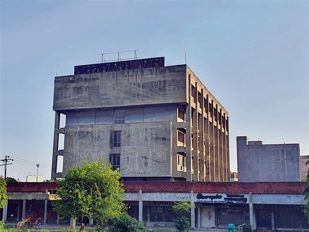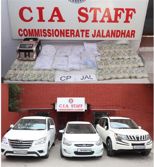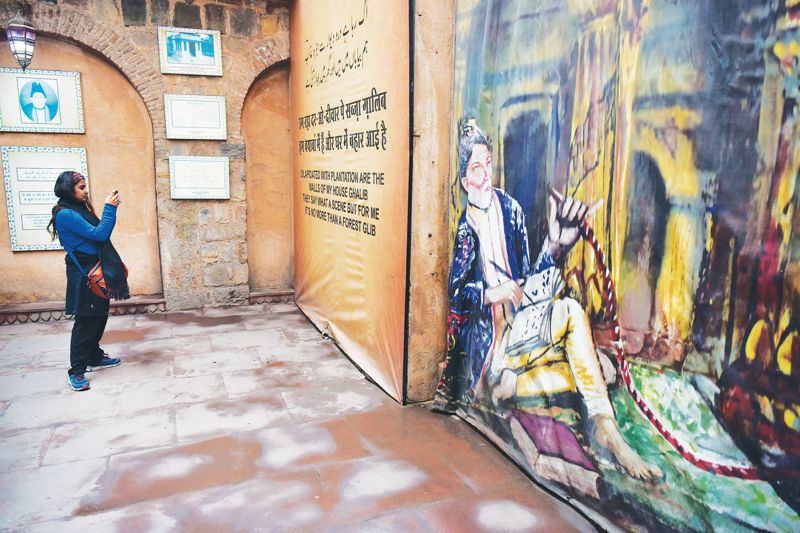
Ghalib Ki Haveli was restored after much persuasion. Photos: Mukesh Aggarwal and Manas Ranjan Bhui
Aksheev Thakur
Opposite the Red Fort stands an over 200-year-old time-worn structure that is now a popular market for electrical and electronic goods. A narrow alley in Chandni Chowk leads to Bhagirath Palace. The stairs are occupied by vendors and electricians, who are unaware — and unconcerned — about the crumbling building’s history and the bygone era of Shahjahanabad (Old Delhi).
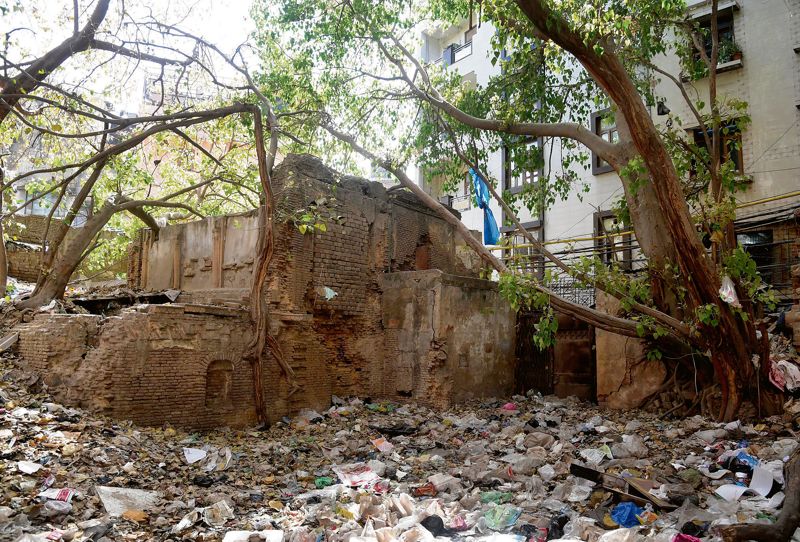
“We call it Bhagirath market. I wasn’t aware that a haveli dating back to the Mughal era stands here. I thought this was an old building which was never repaired. Anyway, those who work here are focused on earning their bread and butter,” says Shamsher Khan, who runs a tea stall outside Bhagirath Palace.

The palace was once called Begum Samru Haveli, named after a Kashmiri girl. She was 14 when an Austrian mercenary, Walter Joseph Reinhardt, got besotted by her. The two got married. For his services to the 17th Mughal Emperor, Shah Alam II, he was given the rich principality of Sardhana in Meerut in 1778.

Trained by Reinhardt, Samru accompanied him on his military campaigns and played a key role in managing Sardhana. After Reinhardt’s death, Begum Samru commanded troops, which included European mercenaries and Indians. In 1787, she was among those who broke the siege of Red Fort and saved Shah Alam II. After her death, the palace was sold off. The name ‘Lloyd’s Bank’, which operated here, remains plastered on the facade. Several shopkeepers may be unaware of the haveli’s history, but believe a tunnel connects it to the Red Fort.

The walled city of Shahjahanabad was built by Shah Jahan. He shifted the capital here from Agra in 1648. The havelis — defined by historian Swapna Liddle as “houses with courtyards” — stood out. With the decline of the Mughal empire and the recapture of Delhi by the British post the 1857 War of Independence, the havelis were neglected. Several faded into oblivion over time.
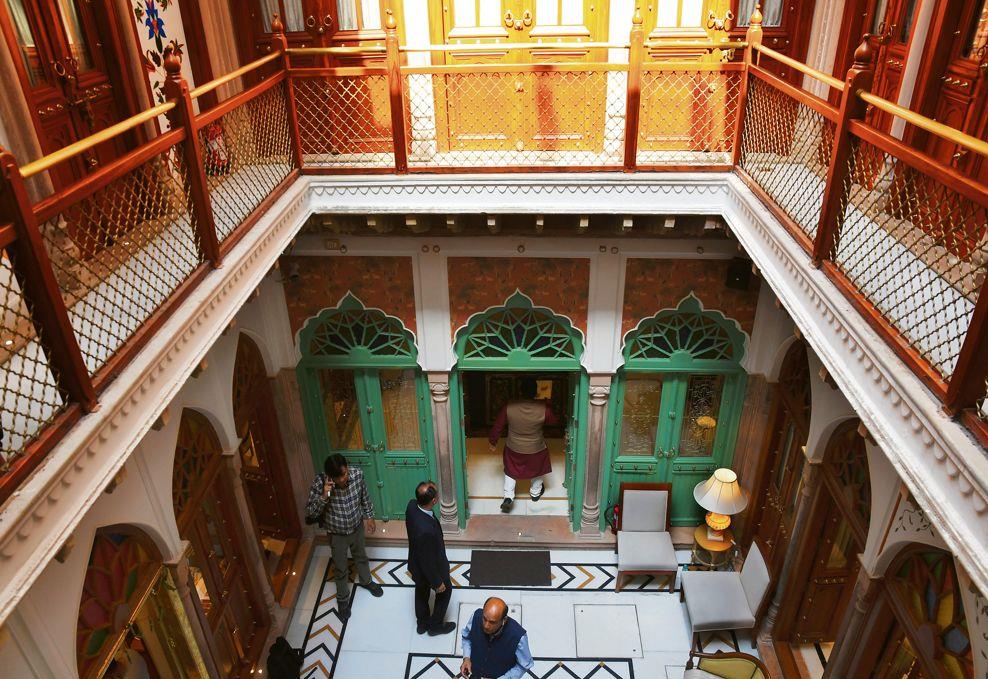
Their preservation, says Liddle, is equivalent to preserving a way of life. “In a city that had narrow lanes and was otherwise congested, we had havelis with open spaces. Today, concrete buildings wither in 60-70 years, these havelis are standing tall for the last 200-300 years and if preserved, they will last long,” she adds.
Abroad, heritage sites are protected. Shahjahanabad is in a very sorry state. Today, these havelis can be counted on fingers. India has abandoned its heritage. — Ashok Mathur, a haveli owner
In 2021, the Delhi government threw open the restored Chandni Chowk, freshly tiled with red sandstone, ornamented with flowerpots and benches for tired feet. Overhead wires were also removed and laid underground, but the restoration of havelis was not on the cards.
Until Ghalib Ki Haveli was restored, it was unknown to the people nearby. They were not aware of its significance... anyway, people suffer from regrettable amnesia. — Pavan K Varma, former diplomat and author
“Government policies lack a comprehensive vision. Aesthetics is one aspect, but here we are talking about preserving a way of life. The government needs to aid owners through financial incentives that would help them view their heritage as assets, not a liability. If these havelis are preserved, it could be a good aspect to boost tourism,” says Liddle.
Taking the cue is Atul Khanna, who hails from Katra Neel in Old Delhi. It was here that the initial war of the 1857 mutiny was fought against the British. Today, it’s a wholesale market of sarees. “The next generation would not know how grand these havelis were in Old Delhi and Rajasthan. Somebody has to showcase this rich tradition. When you save havelis, you save elements like the Mughal and colonial-era architecture, stone pillars and crafts,” says Khanna, a hotelier and heritage conservationist.
On a “mission to preserve the cultural heritage of Shahjahanabad”, he feels commercialisation led to the decline and decay of havelis. “Many were turned into godowns or shops. This led to their destruction,” he says.
Khanna bought two 19th-century crumbling havelis in Sita Ram Bazaar and restored them. Today, he runs the Kathika Cultural Centre there. It has been offering space for performing arts, workshops, screenings, culinary experiences, photography and heritage baithaks. The collection at Kathika includes archival photographs, decorative arts, textiles and crafts.
Khanna, along with a team of architects, worked for over eight years, beginning 2015, to restore the havelis. He says one of the major impediments is multiple ownerships. “The ownership has been transferred over generations. So from whom one needs to buy is an issue.”
With the success of Kathika, Khanna believes that an adaptive reuse of havelis is the way forward. “Transforming them into an art gallery, restaurant or a cultural centre should be encouraged,” he stresses.
Former diplomat Pavan K Varma, who authored ‘Mansions at Dusk: The Havelis of Old Delhi’, says monuments are a symbol of culture and once destroyed, these cannot be retrieved.
“These havelis are our heritage and countries preserve heritage. History may repeat itself, but historical buildings don’t. The reason havelis were neglected is because the focus of power shifted to New Delhi and Old Delhi was left in a cesspool. Even the residents who lived in Old Delhi shifted to South Delhi and only used to visit Old Delhi for businesses. In course of time, Old Delhi became a commercial hub for wholesale goods,” he says.
A haveli, he explains, had two broad divisions — an outer area where the owner entertained visitors, and an inner area which constituted the personal living area. In terms of privacy, a haveli was a fortress.
Varma says that people suffer from “regrettable amnesia”. Those who stay in Hauz Khas and Safdarjung are not aware about the history of these places, he adds.
Havelis, he points out, received a jolt post 1857 when the British recaptured Delhi. “The British used to seize and auction the properties of those suspected of having played a role in the mutiny. These included havelis. Later, railway lines cut through Old Delhi. Several owners left the city. The nawabs left Old Delhi.”
Varma played a prominent role in getting Ghalib Ki Haveli restored. Located in the Ballimaran area of Old Delhi, it was the residence of 19th century legendary poet Mirza Ghalib. The building dates back to the period when the Mughal era was on the decline. Though the government acquired the haveli in 1964, it soon auctioned it to one Mohammed Ali Farooqi. After his death, the ownership passed through multiple hands. Shops, coal stores and manufacturing units came up at the site till the Delhi government took possession of it in 1999. For decades, besides Varma, poets and filmmakers like Gulzar and Vishal Bhardwaj urged the government to restore the haveli. Finally, the then Delhi Chief Minister, Sheila Dikshit, allocated a separate budget for its restoration.
“India has abandoned its heritage havelis,” says Ashok Mathur. Born in 1969 in his ancestral house, a haveli in the heart of Chandni Chowk, he was brought up amidst the rich history of Shahjahanabad. “Abroad, heritage sites are protected. Today, these havelis can be counted on fingers. Shahjahanabad is in a very sorry state. Post-1984, commercialisation of Old Delhi began and the condition of havelis further deteriorated. Those who came here post-Partition integrated with the local culture, but most of those who bought houses here in the past three decades only had commercial objectives,” he says.
“The government should look at these havelis as heritage and be considerate in saving the legacy and culture,” says another haveli owner, preferring anonymity.
Though the erstwhile homes of India’s first Prime Minister Jawaharlal Nehru — Anand Bhawan in Allahabad (now Prayagraj), or Teen Murti House in Delhi — have been converted into museums, Haksar Haveli, where he married Kamala Kaul in 1916, has faded into oblivion. Today, only heaps of garbage can be seen where at one time stood the two-storeyed Haksar Haveli in Sita Ram Bazaar. Only a few senior citizens who have been operating their shops for decades are aware of its
historical significance. The youngsters seem disinterested. The hawkers call it ‘Nehruji ka sasural’.
“You can see snakes and rats at the place. Nobody ever made an effort to preserve it. We got to know about its relevance only through conversations with senior citizens, many of whom have passed away,” says Shamim Haq, who runs a mobile repair shop near the haveli.
Zeenat Mehal Ki Haveli is among the several such tomb-like structures in Chandni Chowk that are lying in a dilapidated state. Constructed in 1846 on the orders of Zeenat Mehal, the beloved third wife of Bahadur Shah Zafar, it was spread over 4 acres. Today, parts of it have been turned into a government girls school and some area has been encroached upon by shopkeepers. An arched gate with dangling wires tells the story of a bygone era.
Amid the neglect, the well-preserved Chunnamal Haveli is a refreshing sight. It was built in the 19th century by Lala Chunnamal, a banker, cloth trader and moneylender. It was said he owned a major chunk of Chandni Chowk and refused a request for a loan by Bahadur Shah Zafar. He left the city overnight in 1857. The haveli has become a famous spot for film shooting. Hindi movies like ‘Delhi-6’ and Hollywood movies such as ‘Holy Smoke’ (starring Kate Winslet) and ‘Nine Hours to Rama’ have been shot here. Hope persists.
Join Whatsapp Channel of The Tribune for latest updates.





















